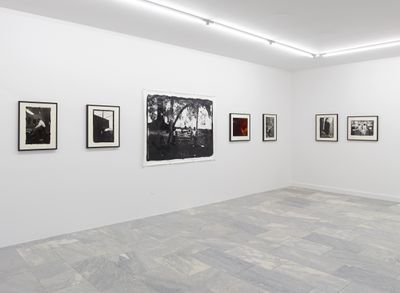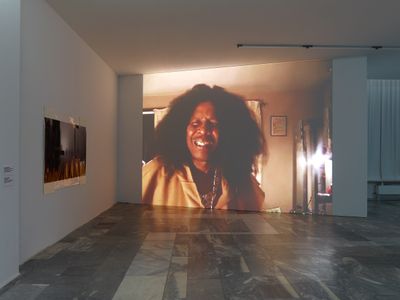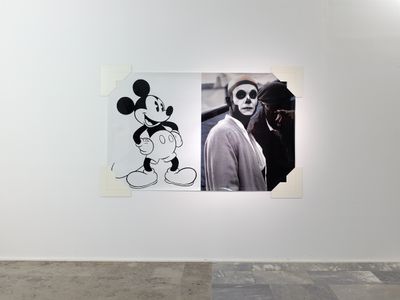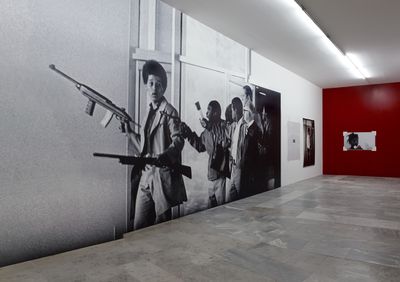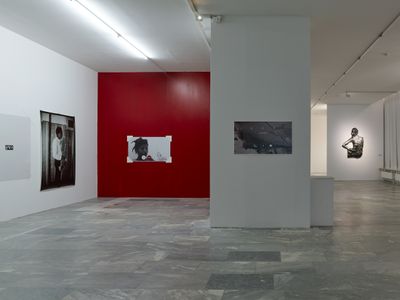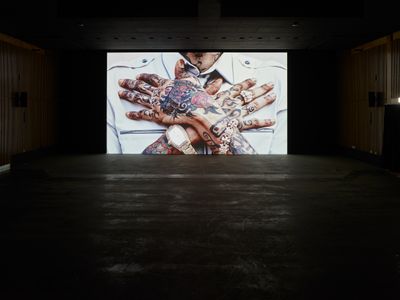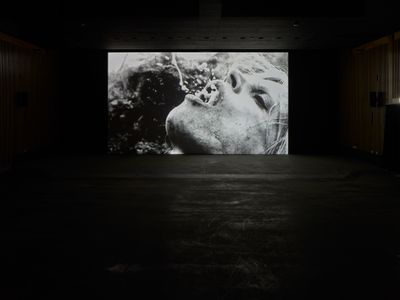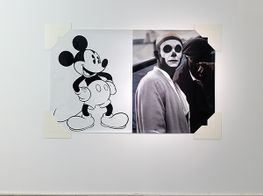Arthur Jafa at Julia Stoschek Collection, Berlin: Viewpoint
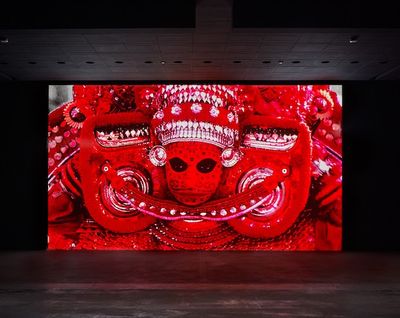
Arthur Jafa, Apex (2013) (Still). Video, colour, sound. 8 min 22 sec. Installation view: Arthur Jafa: A Series of Utterly Improbable, Yet Extraordinary Renditions, Julia Stoschek Collection, Berlin (11 February–25 November 2018). Courtesy Julia Stoschek Foundation. Photo: Simon Vogel.
Arthur Jafa is a brilliant filmmaker, cinematographer and artist, whose practice is concerned with identifying and developing a specifically Black visual aesthetic. His work tackles the complexity of African-American cultural identity, as defined by an existential paradox that places the Black subject 'in essential intimacy with death', as Saidiya Hartman explains in Jafa's documentary Dreams are Colder than Death (2013). The documentary brings together some of the most powerful voices in contemporary Black culture, including Fred Moten, Kathleen Cleaver, and Wangechi Mutu, and looks at the ontology of Blackness and its relations to notions of life, death and what it means to be human in 'the afterlife of slavery'.
Jafa's investigation into Blackness is outlined in the video-montages, collages, and photographic materials that compose A Series of Utterly Improbable, Yet Extraordinary Renditions (11 February–25 November), his exhibition at the Julia Stoschek Collection in Berlin. Curated by Hans Ulrich Obrist and Amira Gad, and developed in partnership with Serpentine Galleries in London, the show interweaves Jafa's work with that of artists Ming Smith, Frida Orupabo and Missylanyus, whom Jafa invited to be part of the exhibition.
A Series of Utterly Improbable, Yet Extraordinary Renditions addresses the intimacy between life and death among bodies that are continuously threatened by systematic cultural erasure and invisibility, and what Jafa describes as 'an inability or unwillingness of the white imaginary to accept the Black being'. How does one represent Black culture and identity in the face of the continuous and systematic process of erasure? Or, to put it in Jafa's own words: 'How do you make a thing an artifact that can resist that wearing away that happens, when it's constantly being bombarded by the gaze, specifically the white gaze'? These questions are addressed across two floors, oscillating between a critical analysis of Anti-Blackness and a celebration of African-American expressivity, music, visual aesthetics, poetics, and counter-narratives.
At the show's entrance, visitors are given headphones with four audio channels to choose from, each for one of the four large screens spread across three rooms that make up Mix1-4_constantly evolving (2017): four video collages for which he artist sliced, cut, and pasted together found and personal footage, from video games, old documentaries and film excerpts, to YouTube video clips, and Instagram photos. These visuals range from a clip of Jimi Hendrix playing at Woodstock, Parliament-Funkadelic's Bootsy Collins dressed in a starman outfit and YouTuber Missylanyus performing in front of the camera, to the frustrated online rant of a white teenager and Jafa's children seen playing with him. Through the headphones, soundtracks move in an out of sync, from Eddie Hazel's 'Maggot Brain' to an a capella version of Screamin' Jay Hawkins' 'I Put a Spell on You', connecting Jafa's video quartet in a series of unmoored narratives. These audiovisual montages allow for continuous ruptures and an evolving reconfiguration that celebrates the multiplicity of Black being by resisting totalising ideologies through which the notion of race has been shaped.
Mix1-4_constantly evolving (2017) dominates the exhibition, visually and acoustically, while a series of collages, photographs, cut-outs and wallpapers shown among the video screens, and others arranged in a single room, complicate its narrative. In the main exhibition space is Mickey Mouse Was a Scorpio (2016): an image of Mickey Mouse juxtaposed with a photograph of a contemporary minstrel, his face painted black with a white skeleton covering his main features, and eyes following the direction pointed by the finger of a man next to him. The work positions Mickey Mouse as an example of the complex way in which Afro-American identity has been fashioned through negation, showing this Walt Disney character not simply as a racist icon, but as a derivative of African-American culture ripped off by the white mainstream. In the gallery, the finger of the man in the image points to where Monster (1988) is displayed; it shows Jafa holding his camera to directly face the viewer, which in this show points back towards Mickey Mouse—a gesture of defiance and an act of resistance against the reduction of the Black body by a racist gaze.
Mickey Mouse Was a Scorpio and Monster combine to create a condensed, programmatic statement among the rest of the works in this room. Also exhibited here is LeRage (2017): a freestanding cut-out of the Incredible Hulk pounding his fist into the ground, his green skin rendered black. Next to this, wallpaper reproducing a 1919 archival image shows the hanging of two Black men, while another blown-up archival image shows Black school children in segregated Virginia saluting the flag of the Union.
Together, these images produce a collapse of time and space, as layers of historical oppression and resistance are brought together. On another wall is a manipulated version of a press photograph blown up to create the wallpaper Jonathan (2017), which shows the Marin County courthouse incident of 7 August 1970, when Black civil rights activist Jonathan P. Jackson, brother of Black Panther George Jackson, took a judge hostage in an attempt to free three members of a group called Soledad Brothers. While Jonathan was killed during a shootout with the police, Jafa imagines a different outcome of the story in this manipulated image, whereby the young man, rifles in hand, walks out of the building alive.
But as powerful as such works are, their arrangement into a single space like this left me feeling torn. On the one hand, I felt a profound appreciation for the rich layering of histories and visual imaginaries on display. On the other, the boldness of Jonathan seemed to overshadow Frida Orupabo's collage placed high up on a column next to it, depicting a female figure formed from pinned-down cut-outs of what look like Black women from colonial times, holding her decapitated head between her hands. Placed at a height in dim light, the collage is hardly visible, as opposed to the large low-fi screenshot made using Facetime of Jafa's pixelated face in Facetime Unavailable (2016–2017), placed on another pillar. In the same room, an intimate black and white self-portrait of Ming Smith, Untitled (Self-Portrait with Camera) (1975–2017), shows a young Smith twisting her body forward against the backdrop of flowery wallpaper while she brings her camera close to her eyes. Hidden in a corner between a large, obscured window and the wall, the photo is painfully easy to miss.
It might be conceivable that the artist's intention was to create a space of dissonance and incessant motion to represent Black existence here. After all, to quote Fred Moten's seminal 2003 text 'In The Breaks: The Aesthetic of the Black Radical Tradition', 'montage renders inoperative any simple opposition of totality to singularity. It makes you linger in the cut between them, a generative space that fills and erases itself.' But this idea does not translate into this show, which leaves scant room between works. Throughout, there is no nuanced differentiation between loud and subtle, layered and direct, not to mention the experience of male and female identities.
What is inevitably lost are the voices that are unable to project as loudly as Jafa's. Throughout, Smith's and Orupabo's voices remain barely audible, making it impossible for the audience to experience their different registers. Indeed, while the power of Arthur Jafa's visual montages lies in the way images are flattened out and compressed into a single body, when the same logic is applied to this exhibition it risks flattening the other artists included in the show. Even the beautiful motion-blurred photographs by Ming Smith of people on the streets of Harlem and elsewhere, which occupy an entire room, risk falling silent next to Jafa's bold visual statements.
Nevertheless, while the exhibition inadvertently numbs the senses with its overload of visual stimuli, in some cases it does give individual works a particular edge. Take Apex (2013), presented in a screening room on the second floor of the building: a compilation of collected and sequenced images—from Michael Jackson to traditional African masks, aliens, superheroes, hip-hop icons, images of lynching, violence on black bodies, a shark, Mickey Mouse, Alvin Ailey and Grace Jones—that flicker at the rhythm of a techno beat. Jafa turns his entire archive into the visual equivalent of a compact wall of sound, creating an ultra-compressed imaginary that hits you with the force of a steam engine.
But even this edge is softened by the fact that the same image material is presented as an open archive in a series of binders arranged on a table outside the projection space for visitors to browse. The rigorous artistic decision to flatten imagery into an ultra-punchy video montage is effectively weakened by the choice to have the same images archived in a sober and orderly manner. The value of opting for radical opacity thus feels annulled by for conventional transparency.
As a whole, some curatorial consideration of each individual artist included within Jafa's frame, perhaps by making each person's presence more specific, would have benefitted the choreography of this show. While Arthur Jafa's practice is rich in that it adopts different modes of address, these different modes appear to get into each other's way in this particular case because there are other voices to consider in it, too. In a similar vein, very little curatorial effort seems to have been made to translate Jafa's practice for the context in which it is being shown. Aside from a very casual conversation between the artist and German art critic Joerg Heiser on 12 February 2018, there have been no further events or discussions to contextualise the works—by staging conversations with the women artists included in this show, for example. Aside from a wall text placed at the entrance of the space containing excerpts from the press material, the press statement is the only source of information; but it is short and formulaic, vaguely articulating Jafa's intention to approximate 'the radical alienation of Black life in the West' but never situating his practice more thoroughly and rigorously within the specific North American context out of which it emerged, which is one among many experiences and cultural manifestations of Blackness.
What this all amounts to is somewhat of a missed opportunity. This could have been an occasion to talk about the pervasive and widely denied racism in the U.S. and Europe, and more importantly consider the crucial questions that Jafa's work raises in the German context, which is witnessing a comeback of far-right nationalisms and widespread racism, yet is also where a vibrant community of artists, writers and curators from around the world work and live in cities like Berlin. If, as Arthur Jafa clearly states in an interview, his work is addressed to Black people, then it feels like the institution has missed an interesting opportunity for dialogue between different experiences of Blackness that Jafa's work opens up to. —[O]
Thank you to Jan Verwoert, Bonaventure Soh Bejeng Ndikung, and Heiko Thandeka for the fruitful conversations.

